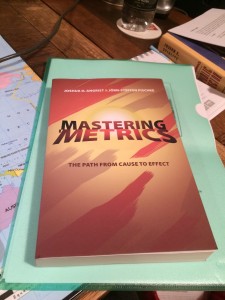On Friday I attended an excellent conference at the Bank of England (organised by the Centre for Economic Policy Research) at which four speakers – Peter Lindert, Jaume Ventura, Orazio Attanasio and Tim Besley – gave presentations on aspects of [amazon_link id=”067443000X” target=”_blank” ]Capital in the 21st Century[/amazon_link], and Thomas Piketty responded to their comments and critiques. The presentations are due to go on the Bank’s website at some stage, although aren’t there yet.
[amazon_image id=”B00I2WNYJW” link=”true” target=”_blank” size=”medium” ]Capital in the Twenty-First Century[/amazon_image]
Peter Lindert drew on material from his forthcoming book with Jeffrey Williamson (and also has a working paper on the Piketty book), to characterise the long-run trends in inequality as the result of ‘lucky’ historical accidents that wipe out concentrations of wealth, combined with policies that help the society stay equal. The period 1910 to the 1970s was the ‘great levelling’, due to wars, and there has subsequently been a fanning out in countries’ experience but in many cases a rise in top incomes. In this, he agrees with Piketty’s book; but disagrees with the famous ‘r>g means rising inequality’ prediction. Demography, technology and politics (mainly education and inheritance tax) – with a role for geography in the case of frontier societies – are his favoured explanations. South Korea, for example, has an inheritance tax of 50%: in principle the heirs of the ailing Lee Kun-Hee of Samsung will be due to pay £4bn in tax when he dies.
Jaume Ventura focussed on the dynamics of economic growth that might explain inequality trends: a u-shaped long-run evolution in the capital-income ratio; the changing components of wealth, with land playing a decreasing part; a not-quite-u-shaped evolution in capital-labour shares (the capital share has risen but is not back to its historic highs); and a stable return to capital of 4-5%. Like Prof Lindert, Prof Ventura does not think the model implied in [amazon_link id=”B00I2WNYJW” target=”_blank” ]Capital in the 21st Century[/amazon_link], and the r>g inequality, stacks up. He argued that the assumptions in the book imply a world of multiple equilibria and cycles or chaotic dynamics, and also that the growth model ignores all the lessons of endogenous growth. He said: “There has been a change in the deep structure of capital in the 21st century.” Bubble-like capital gains now play a large part.
The two final papers moved on from diagnosis to solutions. Orazio Attanasio described the recent research confirming the importance of people’s early years, before the age of 3 and certainly before 10, for their lifetime earnings. Parents’ status and income is important but works through the early effects on a child’s cognitive and non-cognitive abilities. Early experiences even have epigenetic effects. He concluded that the biggest policy problem is the bottom 10% in society, not the top 1%. But also – optimistically – that individuals’ life outcomes can be changed by appropriate early interventions.Prof Attanasio also discussed the optimal level of the top tax rate – recent estimates range from 42% to 86% as the rate that would maximise revenue – to which Thomas Piketty replied that top tax rates should be seen as pollution taxes, the aim being to stop behaviour imposing an externality rather than maximising revenue. However, as 25% of UK income tax comes from the richest 1% (54% from the richest 10%), it would be a bold government that ignored tax revenues.
Tim Besley gave a fascinating talk about the political economy of inequality, referring to his most recent book with Torsten Persson, [amazon_link id=”0691158150″ target=”_blank” ]Pillars of Prosperity[/amazon_link]. He asked, does inequality undermine effective governance? In democracies there is normally thought to be a compact where the rich trade some redistribution in return for security of their property rights. But people don’t mind some kinds of high incomes – footballers vs bankers. And there is no link (looking across countries) between either top (marginal) tax rates and inequality. Quoting Lenin’s [amazon_link id=”014018435X” target=”_blank” ]The State and Revolution[/amazon_link], Prof Besley said there is no empirical support for the frequent claim that the median voter is decisive in political choices: “Democracy for an insignificant minority, democracy for the rich – that is the democracy of capitalist society.” He went on to show evidence that inequality limits the demands for social action, which over time reduces the capacity of the state to act – its legal capacity, fiscal capacity, and capacity to deliver public goods. Finally, he said, there is also evidence that from time to time the values of citizens shift markedly – after the war, for instance, in the overwhelming support for the NHS and welfare state. I couldn’t agree more with his final comment that there are three kinds of economics – the positive, the normative, and political economy.
When I read [amazon_link id=”B00I2WNYJW” target=”_blank” ]Capital in the 21st Century[/amazon_link], I found it hard to work out the growth model implicit in the book, so was reassured that much cleverer economists than me found fault with them. However, as several of the speakers said, that doesn’t make it any less important a book. It has changed the public debate and climate of opinion about inequality, in large part through the long years of hard work giving us the first ever (open) data base of historical figures, the World Top Incomes Database. Jaume Ventura said his advanced macro students have to read it, along with Angus Maddison’s [amazon_link id=”9264022619″ target=”_blank” ]The World Economy: A Millennial Perspective.[/amazon_link] I was also most impressed by Prof Piketty’s openness to the critiques: “Every conclusion in the book is a temporary conclusion, and subject to discussion,” he said.
[amazon_image id=”9264022619″ link=”true” target=”_blank” size=”medium” ]Development Centre Studies The World Economy: Volume 1: A Millennial Perspective and Volume 2: Historical Statistics: v. 1 & 2 combined[/amazon_image]

